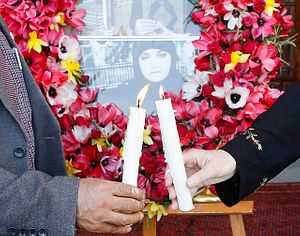In September of 1955, mourners lined up to view the open casket of Emmett Till. Each was horrified by what they saw. Emmett was a 14-year-old African American boy from Chicago on a family visit to Money, Mississippi when he ran afoul of some of the local white men. The official story was that he had whistled at a white woman, raising the ire of the white men who felt compelled to defend her honor. It has always been a ludicrous suggestion, the far more likely scenario was that being from Chicago, Till was simply not sufficiently deferential to one or more of the white men. Regardless, the end result was brutality beyond imagining. The boy was taken to a barn where he was beaten to a pulp and one of his eyes was gouged out. His battered body was then attached to a cotton gin with barbed wire and he was dumped into the Tallahatchie River. While horrendous crimes against African Americans were commonplace in the American South, the sheer brutality inflicted on a child drew tens of thousands of mourners. It was the decision of Till’s mother to open his casket and put her battered son’s body on display for all the world to see that is routinely considered to be the beginning of the American Civil Rights movement. Six months later Rosa Parks refused to give up her bus seat to a white man.
As gruesome as Till’s fate was, it was equaled, if not exceeded, in barbarity with that of a 27 year-old Afghan woman named Farkhunda on March 19 in Kabul. Farkhunda was accused of “burning the Quran” and was attacked by several men who were soon joined by a screaming mob that beat and kicked her and pelted her body with stones. She was then dragged bloodied out into street where she was run over, back and forth, by a truck, crushing her. Then she was set alight to burn. Unlike Till, Farkhunda’s violent end was captured on numerous videos, which have brought the sheer horror and gore of the event to the eyes of millions of people around the world, spawning protests and candlelight vigils.
Like the America of the 1950s, Afghanistan is a nation in dramatic transition. Long held hostage to the machinations of the proxy whims of others, particularly the toxic influence of Pakistan via the export of what came to be known as the Taliban. Washington, to its credit, has learned the woeful lesson of the Reagan era’s careless and neglectful behavior, which ultimately contributed to, if not directly resulted in, the smoldering twin towers of the World Trade Center. The Obama Administration, and Secretary John Kerry have taken a much more proactive and positive posture in the development of Afghan institutions. It has not been, nor will it be, easy or quick work. The first post-Taliban elected leader, Hamid Karzai’s primary skillset was confusing virtually everyone with his ever-shifting positions and liaisons, as he distributed the bounty of international aid to his friends and family. His successor, Ashraf Ghani so far appears to be an improvement but his decision to focus on relations with Pakistan seems a dubious one at best. The prospects of negotiations with the Taliban seem akin to stepping in front of an oncoming train.
But it is with the women of Afghanistan that the real change and real hope lay, which makes Farkhunda’s horrific death before the eyes of the world all the more politically incendiary. Though it may not be apparent from the outside, Afghan women have made great strides since the Taliban era, when they whipped with car antennas for not being sufficiently covered or subservient. A new generation of Afghan women – including artists and politicians – have emerged from the shadows and are increasingly taking their place in society. Courageous schoolgirls brave the threats of acid attacks in order to study and learn, just as their grandmothers did in the days before the Soviet incursion began the downward spiral of the social and physical destruction that set the country back generations. Unlike other equally troubled nations like Iraq or Yemen, the strides of Afghan women bear testimony to the country’s long history of diversity and relative gender equality.
Fannie Lou Hamer, an African American Civil Rights leader once famously described her motivation to ascend to leadership from “being sick and tired of being sick and tired.” Perhaps the soul wrenching tragedy of Farkhunda will provide the same spark Emmett Till’s death did, and unite and engage Afghan women, who have suffered far too long and too deeply. Farkhunda’s final words, as she tried to defend herself were “What was my sin?” Perhaps the entire Afghan nation will recognize her martyrdom – a term for once used appropriately – and know that their collective sin would be inaction in the days and years ahead.
Nasrin Amiri was born in Kabul, Afghanistan and has also lived in India and the United States. She is a graduate of the University of California at Berkeley and is a free-lance writer focused on Afghanistan.

































